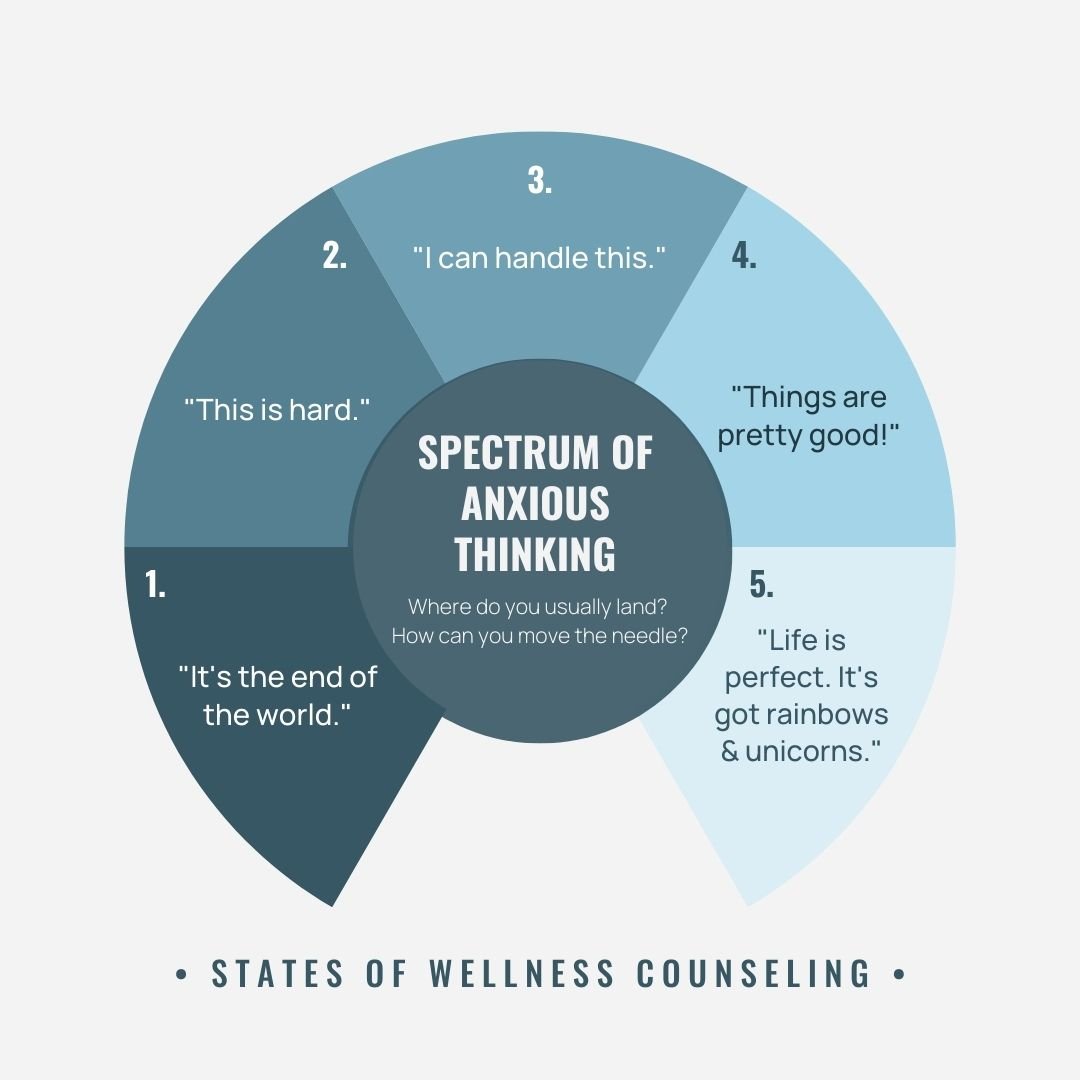How To Challenge Anxious Thoughts: My Number 1 Tip
An anxiety therapist’s number 1 tip for how to challenge anxious thoughts. Hint: it’s not what you may think.
Among the many helpful things you can do for anxiety, challenging your anxious thoughts is probably one of the most impactful. It’s also the hardest. We want our anxiety to go away because it feels miserable and we want it to go away now. Commiting to practicing challenging your anxious thoughts is one of the best ways to actually retrain your brain and find success long term.
So, are you ready for my best piece of advice when it comes to challenging anxiety?
My number 1 tip for how to challenge anxious thoughts: Only replace the anxious thoughts with something realistic that you actually believe.
Keep reading to learn how.
Think of your anxious thoughts as being on a spectrum

At one end, you have thoughts that feel horrible such as:
- “This is the end of the world.”
- "No one likes me."
- "My life is over."
At the other end of the spectrum, it’s all rainbows and butterflies holding hands with unicorns. These thoughts are more like:
- “Nothing is ever wrong!”
- "This is the best day of my life!"
- "Everything is 100% perfect!"
Avoid challenging thoughts with extreme positives
When I encourage my clients to challenge an anxious thought that they are having, time and time again they tend to think I mean “think the opposite” of whatever thought is going through their mind. Trying to challenge worried thoughts with extreme positives is often the wrong approach. For example:
You had an argument with a friend:
- Your anxious thought might be: “They won’t want to be my friend anymore.”
- The extreme positive would be: “They won’t even care about our argument.”
When stuck in traffic on the way to work:
- Anxious thought: “If I’m late to work, I’ll be fired.”
- Extreme positive: “No one will care if I’m late to work.”
Anxiety about your anxiety:
- Anxious thought: “I can’t handle this. I’m never going to feel better.”
- Extreme positive: “I’m feeling calm. This anxiety isn’t even that bad.”
DON’T. DO. THIS. Your brain won’t believe you if you choose a thought that’s simply not true for you. Positive thinking can be helpful, but when we are trying to initially shift our worried thinking it’s usually more beneficial to do so in a realistic way.
Choose realistic thought challenging
Why would we try to convince ourselves that there’s nothing to worry about? Very rarely is that the case. There’s always something we could choose to worry about. You already know that. What we want to do is teach our brain to spend less time at the “end of the world” side of our anxious thought spectrum. We want to recognize when we get to the bottom of an anxiety rabbit hole and bring ourselves out of it… even just a tiny bit.
Instead, try to focus on challenging the worry with something more realistic and believable for your situation. For example:
You had an argument with a friend:
- Anxious thought: “They won’t want to be my friend anymore.”
- Realistic thought challenge: “My friend is upset and might need some time, but we’ve had arguments before and we got through them. I’ve been mad at my friend before and I still wanted to be their friend.”
When stuck in traffic on the way to work:
- Anxious thought: “If I’m late to work, I’ll be fired.”
- Realistic thought challenge: “My boss might ask why I’m late. I can explain there was traffic and that I’ll work to be on time in the future. It might be an uncomfortable conversation, I’d rather not have it, but I’ll survive it.”
Anxiety about your anxiety:
- Anxious thought: “I can’t handle this. I’m never going to feel better.”
- Realistic thought challenge: “Anxiety is hard. I’ve gotten through intense moments of anxiety before. It absolutely sucks right now and I know it will not last forever.”
Why does realistic thought challenging work?
How do you tend to feel when you are worried about something and people invalidate your feelings? It sucks right? It's frustrating and can leave you feeling worse, not better.
They might say something like "Everything will be fine" or "Don't be worried about that!" They're trying to be helpful but it's not what you needed to hear.
Using extreme positives is basically like invalidating yourself. It's not what your brain needs to hear. If you don't actually believe the thought challenge or at least can see how the thought challenge could be true, your brain isn't going to believe you either. Therefore, it's not going to work.
It's hard to challenge worried thoughts. It takes mental and emotional effort to do so and to do so consistently. You are literally retraining your brain. Choosing realistic thought challenging can be more effective because you are acknowledging your feelings, validating them, and identifying when your anxiety took things a bit further than it needed to. It's basically telling your anxiety "it's time to rein it in."
Your goal when challenging anxious thoughts is to move the needle on your spectrum of thinking. It’s not to convince yourself that everything is fine.
You can do this.
Want help practicing how to challenge your anxious thoughts?
I’m a psychotherapist who specializes in helping individuals make progress on their anxiety. If you are in Illinois or Wisconsin, connect with me to see if we may be a good fit to meet your needs and goals. You can also check out my services page to learn more.

